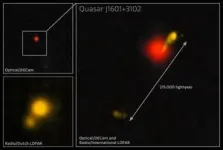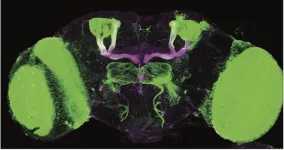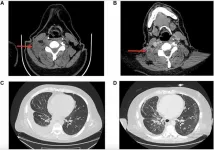(Press-News.org) From decades of astronomical observations scientists know that most galaxies contain massive black holes at their centers. The gas and dust falling into these black holes liberates an enormous amount of energy as a result of friction, forming luminous galactic cores, called quasars, that expel jets of energetic matter. These jets can be detected with radio telescopes up to large distances. In our local Universe these radio jets are not uncommon, with a small fraction being found in nearby galaxies, but they have remained elusive in the distant, early Universe until now.
Using a combination of telescopes, astronomers have discovered a distant, two-lobed radio jet that spans an astonishing 200,000 light-years at least — twice the width of the Milky Way. This is the largest radio jet ever found this early in the history of the Universe [1]. The jet was first identified using the international Low Frequency Array (LOFAR) Telescope, a network of radio telescopes throughout Europe.
Follow-up observations in the near-infrared with the Gemini Near-Infrared Spectrograph (GNIRS), and in the optical with the Hobby Eberly Telescope, were obtained to paint a complete picture of the radio jet and the quasar producing it. These findings are crucial to gaining more insight into the timing and mechanisms behind the formation of the first large-scale jets in our Universe.
GNIRS is mounted on the Gemini North telescope, one half of the International Gemini Observatory, funded in part by the U.S. National Science Foundation (NSF) and operated by NSF NOIRlab.
“We were searching for quasars with strong radio jets in the early Universe, which helps us understand how and when the first jets are formed and how they impact the evolution of galaxies,” says Anniek Gloudemans, postdoctoral research fellow at NOIRLab and lead author of the paper presenting these results in The Astrophysical Journal Letters.
Determining the properties of the quasar, such as its mass and the rate at which it is consuming matter, is necessary for understanding its formation history. To measure these parameters the team looked for a specific wavelength of light emitted by quasars known as the MgII (magnesium) broad emission line. Normally, this signal appears in the ultraviolet wavelength range. However, owing to the expansion of the Universe, which causes the light emitted by the quasar to be ‘stretched’ to longer wavelengths, the magnesium signal arrives at Earth in the near-infrared wavelength range, where it is detectable with GNIRS.
The quasar, named J1601+3102, formed when the Universe was less than 1.2 billion years old — just 9% of its current age. While quasars can have masses billions of times greater than that of our Sun, this one is on the small side, weighing in at 450 million times the mass of the Sun. The double-sided jets are asymmetrical both in brightness and the distance they stretch from the quasar, indicating an extreme environment may be affecting them.
“Interestingly, the quasar powering this massive radio jet does not have an extreme black hole mass compared to other quasars,” says Gloudemans. “This seems to indicate that you don’t necessarily need an exceptionally massive black hole or accretion rate to generate such powerful jets in the early Universe.”
The previous dearth of large radio jets in the early Universe has been attributed to noise from the cosmic microwave background — the ever-present fog of microwave radiation left over from the Big Bang. This persistent background radiation normally diminishes the radio light of such distant objects.
“It’s only because this object is so extreme that we can observe it from Earth, even though it’s really far away,” says Gloudemans. “This object shows what we can discover by combining the power of multiple telescopes that operate at different wavelengths.”
“When we started looking at this object we were expecting the southern jet to just be an unrelated nearby source, and for most of it to be small. That made it quite surprising when the LOFAR image revealed large, detailed radio structures,” says Frits Sweijen, postdoctoral research associate at Durham University and co-author of the paper. “The nature of this distant source makes it difficult to detect at higher radio frequencies, demonstrating the power of LOFAR on its own and its synergies with other instruments.”
Scientists still have a multitude of questions about how radio-bright quasars like J1601+3102 differ from other quasars. It remains unclear what circumstances are necessary to create such powerful radio jets, or when the first radio jets in the Universe formed. Thanks to the collaborative power of Gemini North, LOFAR and the Hobby Eberly Telescope, we are one step closer to understanding the enigmatic early Universe.
Notes
[1] An example of a monster radio jet found in the nearby Universe is the 23 million-light-year-long jet, named Porphyrion, which was observed 6.3 billion years after the Big Bang.
More information
This research was presented in a paper titled “Monster radio jet (>66 kpc) observed in quasar at z ∼ 5” to appear in The Astrophysical Journal Letters. DOI: 10.3847/2041-8213/ad9609
The team is composed of Anniek J. Gloudemans (NSF NOIRLab, International Gemini Observatory), Frits Sweijen (Durham University), Leah K. Morabito (Durham University), Emanuele Paolo Farina (NSF NOIRLab, International Gemini Observatory), Kenneth J. Duncan (Royal Observatory, Edinburgh), Yuichi Harikane (University of Tokyo), Huub J. A. Röttgering (Leiden University), Aayush Saxena (University of Oxford, Durham University), and Jan-Torge Schindler (University of Hamburg).
NSF NOIRLab, the U.S. National Science Foundation center for ground-based optical-infrared astronomy, operates the International Gemini Observatory (a facility of NSF, NRC–Canada, ANID–Chile, MCTIC–Brazil, MINCyT–Argentina, and KASI–Republic of Korea), NSF Kitt Peak National Observatory (KPNO), NSF Cerro Tololo Inter-American Observatory (CTIO), the Community Science and Data Center (CSDC), and NSF–DOE Vera C. Rubin Observatory (in cooperation with DOE’s SLAC National Accelerator Laboratory). It is managed by the Association of Universities for Research in Astronomy (AURA) under a cooperative agreement with NSF and is headquartered in Tucson, Arizona.
The scientific community is honored to have the opportunity to conduct astronomical research on I’oligam Du’ag (Kitt Peak) in Arizona, on Maunakea in Hawai‘i, and on Cerro Tololo and Cerro Pachón in Chile. We recognize and acknowledge the very significant cultural role and reverence of I’oligam Du’ag to the Tohono O’odham Nation, and Maunakea to the Kanaka Maoli (Native Hawaiians) community.
Links
Read the paper: Monster radio jet (>66 kpc) observed in quasar at z ∼ 5
Photos of Gemini North
Videos of Gemini North
Check out other NOIRLab Science Releases END
Gemini North teams up with LOFAR to reveal largest radio jet ever seen in the early universe
The monster jet spans at least 200,000 light-years and formed when the Universe was less than 10% of its current age
2025-02-06
ELSE PRESS RELEASES FROM THIS DATE:
Researchers discover a major driver of inflammatory pathology in autoimmune and chronic inflammatory diseases
2025-02-06
Our immune system is armed with an array of defenses designed to detect and eliminate harmful threats. One of its most powerful defense mechanisms is the complement system—a group of proteins that patrols our body, ever vigilant for signs of infection or injury. Now, over 100 years after the complement system was first described, researchers at Mass General Brigham have discovered that a protein known as granzyme K (GZMK) drives tissue damage and inflammation by activating the complement system against our own tissues. Their findings not only reshape the century-old understanding of the complement system but also open new avenues for therapies that could specifically ...
Research in fruit flies pinpoints brain pathways involved in alcohol-induced insomnia
2025-02-06
Alcohol use disorder, which affects over 10% of Americans, can lead to persistent and serious insomnia. Difficulties falling asleep and staying asleep can last even after months of sobriety, increasing the risk of relapse. But treating withdrawal-related insomnia is difficult, partly because what’s going on in the brain in this condition remains largely mysterious.
Now, research in fruit flies has identified specific brain signals and groups of brain cells that are involved in alcohol-induced insomnia. This work could ultimately lead ...
Cancer diagnoses and deaths are declining in Appalachia but remain significantly higher compared to other US regions
2025-02-06
Key Takeaways:
Appalachia is not uniform: There are important distinctions in cancer diagnoses and deaths among different regions of Appalachia, with certain areas of Central Appalachia experiencing the highest rates of cancer incidence and deaths among the greater Appalachian region.
Higher death rates from cancers that can be caught early with screening: Although the region has improved in screening rates, people in Appalachia still die more frequently from cancers that can be caught early with routine screening than elsewhere in the United States.
Reason for hope: Research can pave the way for targeted interventions that can reduce these ...
Why some heavy drinkers develop advanced liver disease, while others do not
2025-02-06
LOS ANGELES — Why do some people who consume a few glasses of alcohol a day develop advanced liver disease while others who drink the same amount don’t?
The answer may lie in three common underlying medical conditions, according to a new study published in Clinical Gastroenterology and Hepatology from Keck Medicine of USC. The research found that heavy drinkers with either diabetes, high blood pressure or a high waist circumference are as much as 2.4 times more likely to develop advanced liver disease.
“The results ...
OmicsFootPrint: Mayo Clinic’s AI tool offers a new way to visualize disease
2025-02-06
ROCHESTER, Minnesota — Mayo Clinic researchers have pioneered an artificial intelligence (AI) tool, called OmicsFootPrint, that helps convert vast amounts of complex biological data into two-dimensional circular images. The details of the tool are published in a study in Nucleic Acids Research.
Omics is the study of genes, proteins and other molecular data to help uncover how the body functions and how diseases develop. By mapping this data, the OmicsFootPrint may provide clinicians and researchers with a new way to visualize ...
New genetic mutation linked to drug resistance in non-small cell lung cancer patient
2025-02-06
“Here we present a case of a patient with stage IV CD-74-ROS1 fusion NSCLC discovered initially with RNA next generation sequencing (NGS) who acquired resistance to lorlatinib after 6 months on therapy through a novel RUFY1-RET fusion, detected only through RNA NGS.”
BUFFALO, NY - February 6, 2025 – A new case report was published in Volume 16 of Oncotarget on February 5, 2025, titled “Acquired RUFY1-RET rearrangement as a mechanism of resistance to lorlatinib in a patient with CD74-ROS1 rearranged non-small cell lung cancer: A case report."
In this case report, Jenny L. ...
Single-photon LiDAR delivers detailed 3D images at distances up to 1 kilometer
2025-02-06
WASHINGTON — Researchers have designed a single-photon time-of-flight LiDAR system that can acquire a high-resolution 3D image of an object or scene up to 1 kilometer away. The new system could help enhance security, monitoring, and remote sensing by enabling detailed imaging even in challenging environmental conditions or when objects are obscured by foliage or camouflage netting.
“Our system uses a single-photon detector approximately twice as efficient as detectors deployed in similar LiDAR systems ...
Fear of breast cancer recurrence: Impact and coping with being in a dark place
2025-02-06
INDIANAPOLIS – Breast cancer is the world’s most prevalent cancer. Although earlier detection and targeted treatment have resulted in high survival rates, many breast cancer survivors experience fear of cancer recurrence. For some survivors this fear is occasional, for others it is persistent and often debilitating.
A new study of breast cancer survivors has found this psychosocial challenge impacts almost every important domain of their lives – the emotional, behavioral, cognitive, relational and professional. A larger number of domains was affected, ...
Korea University researchers analysis of income-related disparities in mortality among young adults with diabetes
2025-02-06
Korea University Researchers Analysis of Income-Related Disparities in Mortality Among Young Adults with Diabetes
Type 2 diabetics (T2D) under 40 years of age with low income have a threefold higher risk of mortality
Young people with T2D are more affected by income than elderly people with T2D
The research team of Professor Sin Gon Kim and Professor Nam Hoon Kim of department of internal medicine (Endocrinology and Metabolism) of Korea University Anam Hospital, and Professor Ji Yoon Kim of Samsung Medical Center confirmed that young adults with T2D with low income have 3 times higher mortality ...
Study shows link between income inequality and health and education disparities may drive support for economic reform
2025-02-06
New research forthcoming in Social Psychological and Personality Science shows that when people understand how income inequality creates disparities in healthcare and education access, they become more likely to support policies addressing economic inequality.
Across four studies, the research shows that highlighting connections between income gaps and inequalities in health and education access decreases acceptance of economic disparities and increase support for redistributive actions.
"Research has shown that people often tolerate income inequality. However, our study shows that when people perceive ...
LAST 30 PRESS RELEASES:
University of Oklahoma researcher awarded funding to pursue AI-powered material design
Exploring how the visual system recovers following injury
Support for parents with infants at pediatric check-ups leads to better reading and math skills in elementary school
Kids’ behavioral health is a growing share of family health costs
Day & night: Cancer disrupts the brain’s natural rhythm
COVID-19 vaccination significantly reduces risk to pregnant women and baby
The role of vaccination in maternal and perinatal outcomes associated with COVID-19 in pregnancy
Mayo Clinic smartwatch system helps parents shorten and defuse children's severe tantrums early
Behavioral health spending spikes to 40% of all children’s health expenditures, nearly doubling in a decade
Digital cognitive behavioral treatment for generalized anxiety disorder
Expenditures for pediatric behavioral health care over time and estimated family financial burden
Air conditioning in nursing homes and mortality during extreme heat
The Alps to lose a record number of glaciers in the next decade
What makes a good proton conductor?
New science reporting guide published for journalists in Bulgaria
New international study reveals major survival gaps among children with cancer
New science reporting guide published for journalists in Turkey
Scientists develop a smarter mRNA therapy that knows which cells to target
Neuroanatomy-informed brain–machine hybrid intelligence for robust acoustic target detection
Eight SwRI hydrogen projects funded by ENERGYWERX
The Lundquist Institute and its start-up company Vitalex Biosciences Announces Strategic Advancement of Second-Generation fungal Vaccine VXV-01 through Phase 1 Trials under $40 Million Competitive Con
Fine particles in pollution are associated with early signs of autoimmune disease
Review article | Towards a Global Ground-Based Earth Observatory (GGBEO): Leveraging existing systems and networks
Penn and UMich create world’s smallest programmable, autonomous robots
Cleveland researchers launch first major study to address ‘hidden performance killer’ in athletes
To connect across politics, try saying what you oppose
Modulating key interaction prevents virus from entering cells
Project explores barriers to NHS career progression facing international medical graduates
Jeonbuk National University researchers explore the impact of different seasonings on the flavor perception of Doenjang soup
Two Keck Medicine of USC Hospitals named Leapfrog Top Teaching Hospitals
[Press-News.org] Gemini North teams up with LOFAR to reveal largest radio jet ever seen in the early universeThe monster jet spans at least 200,000 light-years and formed when the Universe was less than 10% of its current age








